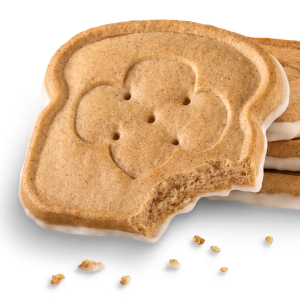Time to come home from our world-rambling ‘Expedition To…’ series for a catch-up on what Dr. Obvious has been doing. I’ll leave it up to you to decide whether the two ‘food stories’ we feature today really merit having stories written about them in the first place – let alone learned studies conducted by real, legitimate university labs…
 The new French Toast flavoured Girl Scouts Cookie:
The new French Toast flavoured Girl Scouts Cookie:
Can it turn the organization’s fortunes around?
We haven’t heard much from Dr. Obvious for a while. Turns out there’s a good reason. He’s been recovering from a mild nervous breakdown triggered by an overload of food-related news and learned study reports that seek to dress up common sense in white coats and high-flown jargon. Let’s start with the report on a new university study that went to extremes to demonstrate a principle everyone who eats – and that’s everyone – has probably intuited by age 10…
‘You eat what you are’
A research team from North Carolina State University asked, “Does evolution explain why we can’t resist a salty chip?” Their theory postulated that our taste buds evolved over thousands of generations in response to our bodies’ needs for specific elemental materials.
“Because animals have very limited ability to change their elemental composition, the old adage that ‘You are what you eat’ doesn’t really apply,” says says Dr. Lee Demi, a Co-Author of the study and postdoctoral researcher in NC State. “Rather, animals are rewarded with pleasing tastes for ‘eating what they are’, at least from an elemental composition perspective, which helps reduce the prospect of dietary nutrient limitation.”
“Affinity for certain foods must have strong evolutionary drivers, because without taste, animals would be forced to overconsume everything in the hopes of hitting the magic ratio of elements needed for growth and development,” says Dr. Benjamin Reading, Co-Author of the study and a professor at NC State. “They would need to eat way too much and end up excreting huge quantities of those things they need less of, which is not efficient.”
Duh.
That might explain why we have taste buds tuned only to a small range of stimuli: sweet, sour, salt and bitter. Of course, there’s also the new kid on the tongue, umanmi. But that, too, has been traced to an elemental stimulus – nitrogen.
Really, though, don’t we all know (dare I say, instinctively?) what to eat and what not to eat? If not, what are cravings for?
“Perhaps I over-simplify,” Dr. Obvious allows. ” But this is the kind of thing that almost put me in the bug house!”
Who ordered al the cookies?
Preamble: In the U.S., they call the Girl Guides the ‘Girl Scouts’. Everywhere else in the world (except Russia) they are called ‘Guides’. Anyway…
The Girl Scouts are facing a cookie crisis. It’s estimated that, across the U.S. the Girl Scouts are sitting on something like 15 million unsold boxes of cookies in all 28 flavours, including a new French Toast specialty introduced just this past year.
It’s not that the kids haven’t been trying. But how can you sell cookies door to door with a COVID-19 lock down in force? And how can your parents flog ’em by the case to office colleagues when everyone’s working from home? Another factor eroding Cookie sales is a precipitous drop in Girl Scouts membership – again, they say, thanks largely to the pandemic.
In response, the Scouts tried to convert their sales program to a virtual protocol in order to offer a contactless experience. They also engineered a delivery partnership with Grub Hub. And they even donated some cookies to first responders, local volunteers, and other local causes. But they still have a whole lot left over.
In the end, they were still left with a huge surplus – though 15 million boxes out of a normal order of about 200 million boxes from the multiple bakers the Girl Scouts use may not sound like much, it still represents a major financial hit. The loss of revenues will impact Troop-level activities such as regular programs, travel, camps and day-to-day activities (such as awarding badges, etc.).
There’s also a clock on the situation: Girl Scout Cookies have a shelf life of about a year, regardless of the variety. The organization has to get rid of the surplus in positive, responsible ways or risk throwing out (wasting) a lot of food. Not good PR exposure.
Not to mention that this year’s Cookie Season is on the horizon.
Interested in helping the Girl Scouts get rid of their excess Cookies? Visit this official website to learn how you can contact them in your part of the country.
Dr. Obvioius notes that Girl Scouts of the USA spokesperson Kelly Parisi did admit that a decline in sales, “was to be expected.” If so, who the heck ordered all the excess cookies?
“I wonder if I can double up on my tranquilizers?” Dr. O. just asked, aloud…
~ Maggie J.

